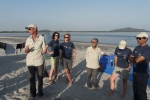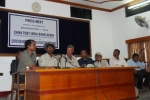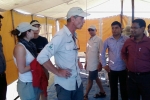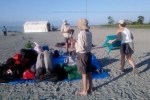Brahmaputra River Expedition -2010 collaborates with the Centre for North East Studies & Policy Research (C-NES)
Brahmaputra Expedition – 2010
An international team traversing the Brahmaputra river from Tibet through North-east India into Bangladesh is collaborating with the Centre for North East Studies and Policy Research (C-NES), in the sector of community heath. The focus of this collaboration is to explore initially support for rapid emergency evacuation of patients from remote inaccessible habitations in Brahmaputra with fast-motorized inflatable boats.
Led by the Swiss river expert Andy Leemann, the expedition set out to cover the entire length of the Brahmaputra, on foot and by boat, covering almost 3,000 kilometers from the headwaters near Mount Kailash in Tibet to the delta in the Bay of Bengal in Bangladesh. The expedition’ says that its overarching objective is to establish greater focus on the people who live by the rivers and river ecology.
C-NES’ involvement with the Brahmaputra is preceded by the interest and passion of its Managing Trustee, Sanjoy Hazarika, who as journalist, researcher and film maker, has traveled along the route taken by the expedition in the 1990s, in some areas with the renowned film maker Jahnu Barua. Hazarika, who has traveled on the river in Tibet, Bangladesh and North-east India, took these journeys as far back as the 1990s, well before founding C-NES in 2000. Other travel preceded this as part of family journeys and holidays but always kindling a deep interest in the power of the river to mould cultures and Assam’s civilization.
One of the films that emerged from these travels as ‘A River’s Story, the quest for the Brahmaputra’ directed by Barua and proecued and scripted by Hazarika (who writes the scripts for all his films) screened at many international venues; then followed Brahmaputra, directed by Gautam Bora and produced by Hazarika for Doordarshan. In 2008, he produced and scripted Maulee Senapati’s film on river dolphins: Children of the River – the xihus of Assam. Hazarika plans a set of short films about the boat clinic intervention in 2011. Hazarika, a well known authority at the national and international levels on the North East, conceived the idea of the boat clinics after hearing the story of a young woman who died along with her unborn baby while trying to get to a hospital from an island in the Brahmaputra. “This was unacceptable, there must be ways of getting services to people instead of them struggling to come for the service,” he thought. That developed
into the boat clinics, which in partnership with the National Rural Health Mission, Government of Assam, is reaching lakhs of persons on the islands of the river with sustained health care.
The expedition members of the 2010 odyssey undertook an exercise to familiarize with the health and logistic issues and identify the need for the right kind of boat required for CNES’s health program in Dibrugarh district. Mr. Amrit Bora, District Program Officer, C-NES assisted the team in this effort, provided useful information and was very patient in answering queries posed by the expedition team.
The expedition team along with Mr Amrit Bora of CNES left Dibrugarh at noon to arrive at Aichung sapori, an island on the Brahmaputra, two and a half hours later. The river was difficult to navigate with numerous sand banks on the way.
The Aichung health camp was very well organized, a well equipped boat clinic (named SB AKHA) which is the pioneer boat of C-NES had embanked by the shores which was equipped with a pathological lab. The team learnt that the boat clinic visits Aichung twice a month at regular intervals. The dates of the health visits are decided in consultation with the people and the district health authorities and took into consideration the local events and festivals in planning out the program. A field clinic tent was laid out on the island not far from the boat clinic. It was very well equipped and had two attending doctors, a pharmacist, a GNM and two ANMs. It had an examination room which provided for privacy and examinations were done in a calm professional manner. The team observed that the medical staff members were very diligent and sincere in discharging their responsibilities.
70 patients were examined and records of each patient were entered in a register for easy reference and for future monitoring. What was impressive that even at 6.00 am the doctors took the time to examine the patients who visited the clinic without any fuss. The pharmacy too was well stocked and included antibiotics apart for simple medicines for fever and pain.
Expedition Itinerary
The first phase of the expedition starts from the southern Tibetan Plateau where the Yarlung Tsangpo (Sky River) originates in the Chemayung-Dung glacier in a remote mountain mass near Mount Kailash (6,638 mt.)— making it the highest major river in the world. After leaving the plateau it flows around Mount Namche Barwa (7,782 mt.), into the world’s longest and the deepest gorge — the Yarlung Tsangpo Grand Canyon.
The first section has been already traversed, taking the team over some very challenging high altitude treks and rafting in inflatable boats down some of the most punishing rapids in the world. In the second phase, the expedition rejoins the river again in Assam and traverses downstream through Bangladesh right up to the Bay of Bengal.
Objectives of the Expedition
The expedition’s primary objectives, as with all other river expeditions earlier undertaken by Andy Leemann earlier, have been to establish greater focus worldwide on river ecology, as well as the livelihood and culture of people who live on and by the river. Like earlier, it plans to bring in national and international media professionals who would travel on the expedition and write their experience first hand highlighting issues concerning rivers and the people. Besides, it would take the opportunity to focus internationally on the effects of climate change and rise of sea level on Bangladesh and suggest possible mitigative measures. It is also exploring the possibility of promoting eco-responsible tourism, sustainable livelihoods for people who live by the rivers and long term measures for conserving ecological capital.
Media.
On 10 November 2010, the expedition members interacted with about 30 journalists at the Guwahati Press Club, an event organized by C-NES. Eleven members of the expedition team were present at the press meet. Apal Singh, Co-expedition Leader, welcomed the media and introduced the team members. He also spoke about the objectives of the expedition team and gave a brief background of the expedition so far. Mr Leeman, provided more details about the expedition, supported with striking photographs from the source of the river in Tibet. He described about the good and challenging times of the expedition, including an incident when some of the members had a lucky escape when they were entering India and the river was in spate. The photographs also showed pictures of C-NES Dibrugarh boat clinic team treating patients. Thanking C-NES for collaborating with the Expedition, he said boat clinics were providing a great service but highlighted the need for speedier and faster
boats to increase their reach.
Mr Ashit Kumar Mitra, NGO Activity Coordinator, also described C-NES’ work as very “crucial and significant”. Mr. Sanjay Sharma, Associate Programme Manager, C-NES, gave a brief background of the organization and the collaboration with the expedition team.
The media asked about the journey and later, television teams, including NDTV, traveled on the speed boats to the base camp, was around 7 kms from Guwahati Ujan Bazar ghat and were briefed about how the team lived, food services, daily schedules etc. Ashok Rao, Manik Boruah, Bhaskar Jyoti Saud & Hiranya Kumar Deka of C-NES also attended the press meet. Sanjay Sharma, Bhaskar Jyoti Saud and Hiranya Kumar Deka from C-NES also sailed on the dinghies to the camp, which Sharma describes as an “incredible and adventurous experience when a distance of about 7 kms was covered in five minutes!”





